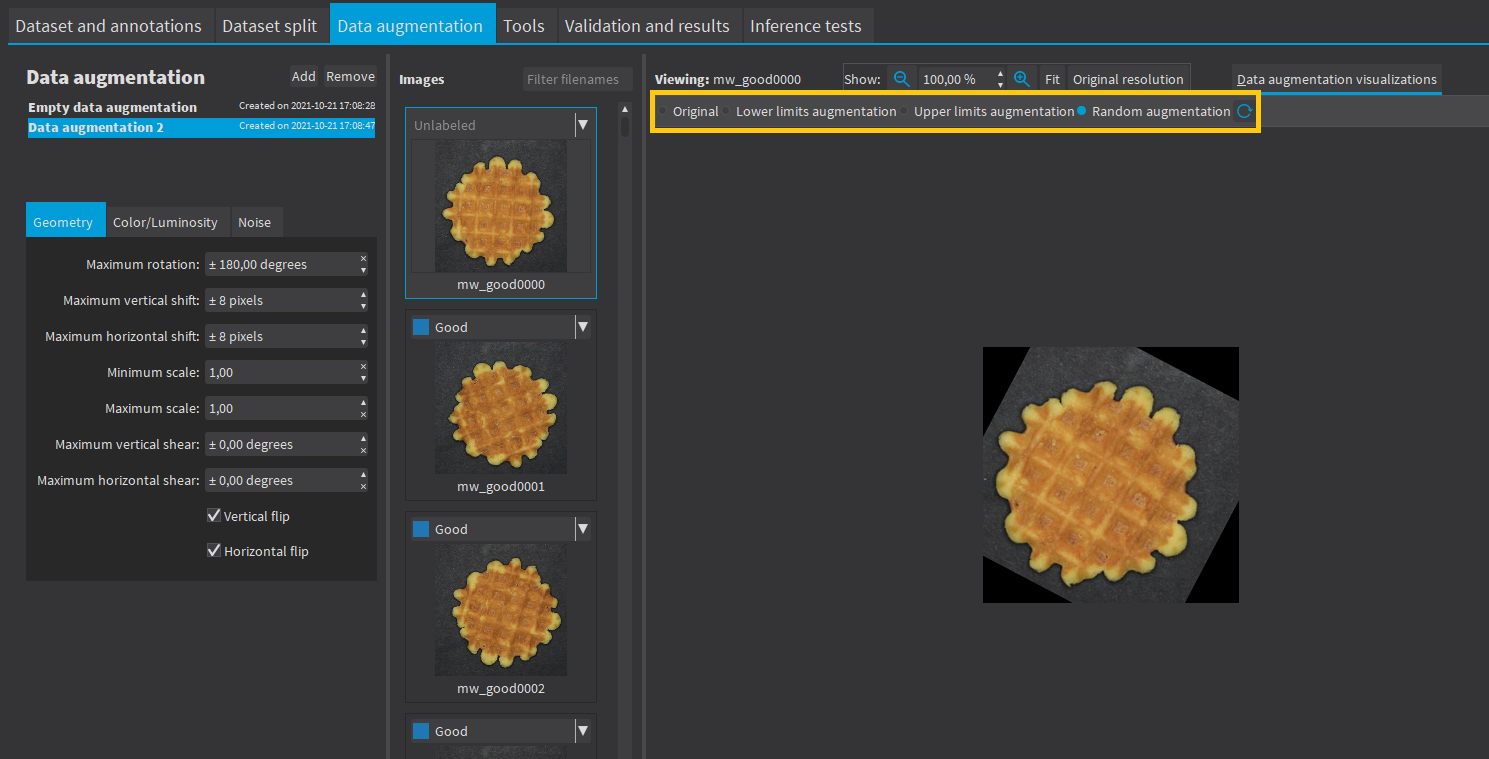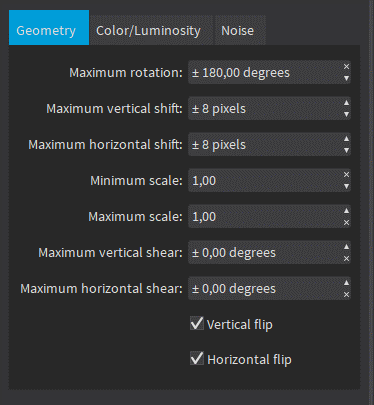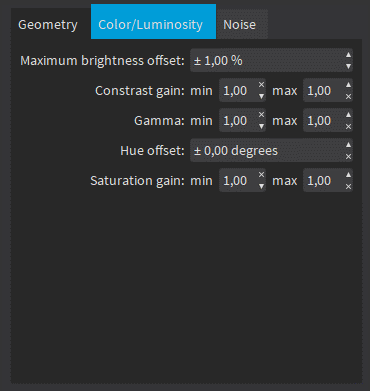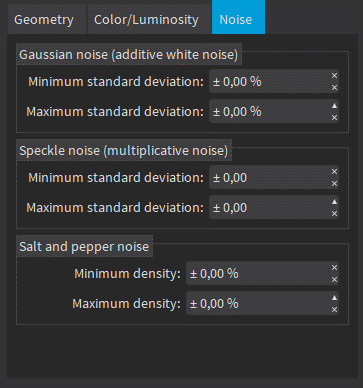Data augmentation performs random transformations on images given to a deep learning tool (EClassifier, EUnsupervisedSegmenter or ESupervisedSegmenter object) during the training.
| ● | データ拡張に最適なパラメータを選択するために、さまざまな設定を試してください。 |
| ● | Configure data augmentation according to your problem. However, flips, shifts (20 - 40 px), brightness (5%), contrast (0.95 to 1.05) or salt and pepper noise (2%) can be useful on many datasets. |
| ● | 変換によって画像のラベルが変更されないことを確認します(たとえば、回転やコントラストの変更によって画像特徴が消えてしまうなど)。 |
With EasyLocate, we do not recommend to use rotation and shear data augmentation as it is not possible to compute the minimal bounding box surrounding the object after these geometric transformations.
In Deep Learning Studio
| ● | Create and configure the data augmentation settings in the Data augmentation tab. |
| ● | 最小設定(下限拡張)、最大設定(上限拡張)、またはランダム設定(ランダム拡張)で水増しした画像データを表示および確認します。 |

APIでは
Use EClassificationDataset::SetEnableDataAugmentation(true/false) to enable or disable these transformations or directly use an object EDataAugmentation that you give to the method EDeepLearningTool::Train.
The transformations
幾何学変換

| ● | Horizontal and vertical flips (enabled with EClassificationDataset::SetEnableHorizontalFlip and EClassificationDataset::SetEnableVerticalFlip) |
| ● | Scaling (between a minimum and maximum value defined with EClassificationDataset::SetMinScale and EClassificationDataset::SetMaxScale) |
| ● | Horizontal and vertical shifts (between –maxValue and maxValue defined with EClassificationDataset::SetMaxHorizontalShift(maxValue) and EClassificationDataset::SetMaxVerticalShift(maxValue)) |
| ● | Rotations (between 0 and a maximum value defined with EClassificationDataset::SetMaxRotationAngle) |
| ● | Horizontal and vertical shear (between –maxValue and maxValue defined with EClassificationDataset::SetMaxHorizontalShear and EClassificationDataset::SetMaxVerticalShear) |
色および明るさの変換

| ● | Brightness offset (between –maxValue and maxValue defined with EClassificationDataset::SetMaxBrightnessOffset) |
| ● | Contrast gain (between a minimum and maximum value defined with EClassificationDataset::SetMinContrastGain and EClassificationDataset::SetMaxContrastGain) |
| ● | Gamma corrections (between a minimum and maximum value defined with EClassificationDataset::SetMinGamma and EClassificationDataset::SetMaxGamma) |
| ● | Hue offset (between –maxValue and maxValue defined with EClassificationDataset::SetMaxHueOffset) |
| ● | Saturation gain (between a minimum and maximum value defined with EClassificationDataset::SetMinSaturationGain and EClassificationDataset::SetMaxSaturationGain) |
ノイズ変換

標準偏差は、ピクセルの最大値のパーセンテージとして表されます。
| ● | Gaussian noise, also called additive white noise, generated with a standard deviation (between a minimum and maximum value defined with EClassificationDataset::SetGaussianNoiseMinimumStandardDeviation and EClassificationDataset::SetGaussianNoiseMaximumStandardDeviation) |
| ● | Speckle noise, a multiplicative noise, generated from a Gamma distribution with a mean of 1 and a standard deviation (between a minimum and a maximum value defined with EClassificationDataset::SetSpeckleNoiseMinimumStandardDeviation and EClassificationDataset::GetSpeckleNoiseMinimumStandardDeviation). |
| ● | Salt and pepper noise generated from a pixel density (between a minimum and a maximum value defined with EClassificationDataset:: SetSaltAndPepperNoiseMinimumDensity and EClassificationDataset::SetSaltAndPepperNoiseMaximumDensity). |
